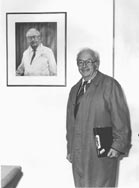David G. Cogan Biography
Dr. David Glendenning Cogan
by Dr. Carl KupferAmong the great names in the history of twentieth century ophthalmology, David Glendenning Cogan clearly is one of the most outstanding, considering his research accomplishments, clinical skills, insights, and teaching contributions over six decades.
In 1940, at the age of 32, he became director of the Howe Laboratory of the Harvard Medical School and remained its Director until 1973. During this time, the Howe Laboratory became an incredibly productive ophthalmic research laboratory, setting a high standard in research worldwide. Morton Grant, Jin Kinoshita, Toichiro Kuwabara, and David Donaldson were among the many young researchers who flourished in this stimulating research environment. Dr. Cogan contributed greatly to the direction of ophthalmic research (corneal, pathophysiology, and small vessel disease in diabetic retinopathy) and made significant contributions to medical subjects (atherosclerosis) and the field of neurology (oculomotor apraxia). He wrote two concise and critically written books on the neurology of the oculomotor system and the neurology of the visual system.
During this period of 33 years, Dr. Cogan also served as Chairman of the Department of Ophthalmology, Harvard Medical School; chief editor of Archives of Ophthalmology; and a member of the editorial boards of Investigative Ophthalmology and the Albrecht Von Graefes Archiv fur Klinishe und Experimentelle Ophthalmologie. He was also among the initial members of the National Advisory Eye Council of the National Eye Institute (NEI), National Institutes of Health (NIH) in Bethesda, Maryland.
Upon retirement in 1973 from Harvard, I invited Dr. Cogan to join the research laboratory of the NEI as a Senior Scientist. For the next 20 years, he continued to be extraordinarily productive in research. He worked closely with younger members of the staff, encouraging their research activity and helping them find positions in scientific establishments worldwide. His involvement shaped the ambience of NEI's research laboratories to one of collegiality and mutual assistance, qualities that Dr. Cogan held in high regard.
With his death in 1993, there passed from ophthalmology one that stimulated the best in young investigators; an author of more than 500 articles, the vast majority with Dr. Cogan as first-author; and a person who always gave much more than he received. In 1985, when the David Cogan Library was dedicated at the NEI, his impact on ophthalmology was recognized with these words: "So great have been Dr. Cogan's achievements in all three areas of research, patient care, and education-that he, more than anyone else, is credited with transforming the field of ophthalmology from a branch of surgery into a medical specialty at the forefront of science."
Photographs

Portrait of David Cogan |

David Cogan in 1960 |

David Cogan at dedication of NEI's Cogan Library |

Carl Kupfer |
||


